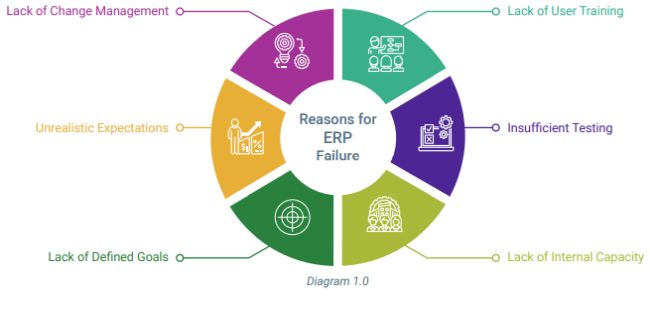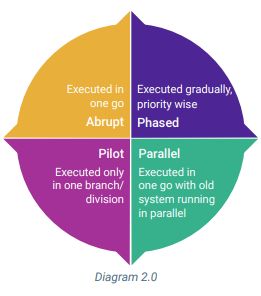ERP has become imperative for the growth of an organization as it allows smooth integration of all the business processes and offers a holistic solution. With an ERP system the optimum value and objective can be achieved when it provides the desired information that enhances decision making capabilities. ERP needs to be designed according to the entity's business and its processes. Thus, the correct implementation of ERP is very important for the organization to reap optimum benefits.
Implementation of ERP abruptly could have numerous consequences that will eventually affect an organization's overall growth on a large scale. For instance, if the ERP implementation in a manufacturing unit goes wrong; the sales manager would struggle to get his forecast reports, the production manager would find it difficult to obtain accurate inventory reports, and the finance team would need to coordinate with multiple stakeholders to get hold of accurate MIS reports. This chaos can affect the company's operations and overall growth plans.The reasons for ERP failures can be internal or external.
ERP implementation's high failure rate has resulted in negative impacts, such as business losses, falling market price, losing market share, and competitive advantage to many companies. Hence, ERP implementation should be more of a guided process which is planned systematically. In this article, we will navigate a roadmap that is generally followed during a successful ERP implementation.
Expectations from ERP and Existing Business Processes
An ERP covers overall business processes and gives results for the entire operations. Business processes differ from entity to entity, even if in the same industry. The need for an ERP is evaluated basis the problems faced in the existing system and the necessity for improvements. Expectations from an ERP should be documented by way of a Request for Proposal (RFP). RFPs help project the vision of an ERP and what is expected out of it. Additionally, a process document depicting the existing end-to-end business processes should be documented along with the controls that the management requires within the system to understand the current processes on which the business is dependent.
Budget and Timelines
A budget dedicated to ERP should be finalized after its need and expectations are drawn out. The budget helps bridge the gap between the expectations from the ERP and affordability. It is time-sensitive, which means the timeline for ERP implementation will lead to budget changes and vice-versa. Projected timelines can be extended due to technical as well as non-technical reasons, however, it is critical to monitor the projected timelines and adjust them from time to time, considering the challenges and budget.
ERP Manifest Designing
ERP is meant for establishing a simplistic approach in operations. Business processes that were scattered earlier will be combined in ERP, module-wise, resulting in an ERP manifest. A Business Requirement Document (BRD) can be prepared where solutions expected from an ERP and any constraints that can impact an ERP's successful deployment are listed. This implementation step may result in modification of existing processes, making them effortless. The module is primarily a division of the business operations, e.g., Sales, Purchase, Finance, Fixed Assets, HR, etc. Processes mapped for each of these divisions will be configured in the ERP. A considerable amount of time should be spent designing the ERP for the desired outcome to achieve optimum results and avoid any lasting impact on other implementation stages and the project's overall development.
Feasibility Study
Once the ERP manifest is illustrated, the next stage will be conducting a feasibility study. The ERP design should be feasible from a financial, operational as well as technical perspective. In case it fails, one has to analyze what can be possibly eliminated or integrated to make the design feasible from all perspectives. Return on Investment (ROI) on implementing ERP should also be calculated to measure the gains that the business is receiving out of ERP from a finance perspective. Such ROI also forms a key directive to assess the feasibility of ERP.

Development and Implementation
During the development phase, the Business Requirement Document prepared at the time of ERP designing should be referred. Active participation from all business partners will be required during development. This includes providing accounting rules, logic, documenting and simplifying critical processes, highlighting automation possibilities, designing the access and approval matrix, and much more.
Pre-implementation Testing
After the ERP is developed based on business requirements, it needs to be tested to review the business processes carried out through the ERP and the results obtained from the same. From a finance perspective, pre-implementation testing can be performed in the following ways:
Dynamic Analysis Testing comprises a set of data with predetermined results. System results are compared with such pre-determined results. There are three types of dynamic analysis testing: Black Box, White Box and Gray Box. The first type of testing contains module-wise test data with determined results, while the second type includes complex test data covering all the modules, thereby testing the process integration. The third one is a combination of both white and black box testing.
Acceptance Testing ensures that ERP satisfies the quality standards of the business and the users. Quality standards testing ensures that the ERP is in line with the quality assurance policy of the organization. User satisfaction involves training the staff who will be operating the ERP i.e., inputting data at every end.
Parallel Testing is a comparison-based test; while the old system is still operating, the same data is fed into the newly implemented ERP and both the results are compared are compared. Such testing can be performed if a parallel implementation is selected.
System Implementation
After having all the processes embedded in the ERP, the next concern is how the implementation should be carried out.

Selection of the type of implementation depends on many directives, a primary one being cost. The more the budgeted cost, the more systematically it can be implemented. For example, in high-budget scenarios, phased or parallell implementation can be selected and vice versa. The success of an ERP depends on how it has been implemented.
Data Migration
Data from the previous system should be migrated to the implemented ERP for business continuity. Data migration can be full or partial. Depending on the volume of data and its complexity, a decision can be taken on migrating the data. When data is migrated in full, ERP gets updated with historical data too, but at the same time, this process can become tedious, time-consuming and may be prone to errors. Partial data migration tends to keep tabs on unidentified ERP implementation errors since the volume of data is considerably low. Although it is considered a systematic way of data migration, there will always be an old system for past data reference.
Post-implementation Phase
Review step reveals the success of ERP implementation and unveils the errors. Post-implementation testing can be performed using the same steps which were adopted during pre-implementation testing.
Hyper Care and Technical Support are required until the team and the organization settles down with the new ERP. Modifications, errors, and automation of processes wherever possible get identified with successive usage. The duration of availing the technical support is not standard across all organizations and would vary depending on staff awareness and training, process efficiencies, etc.
Training should be conducted at regular intervals to ensure the team is acquainted with the new ERP's functionalities and reap the maximum benefits out of it.
In conclusion, the success of ERP depends on its implementation, and the following five factors are very critical for it:
- ERP Designing
- Feasibility Study
- ERP Testing
- Selection of Implementation Process
- User Acceptance and Discontinued Technical Support
50% of ERPs fail in the first trial because of implementation gaps. Hence, the implementation stage should have more emphasis than all other steps in the transition process. A successful ERP implementation will lead to efficiency enhancement throughout the entire organization. The above roadmap will provide a step-by-step guidance to implement ERPs in a systematic manner.
Appendix
Given below are the latest ERPs in the market
SAP: SAP ERP is an application plus data management system. It provides a set of tools to facilitate information flow in a business.
https://www.sap.com/india/index.html
NetSuite ERP: It is best suited for a fast-growing business as it allows high automation in business processes. Though there is not much difference between NetSuite and SAP, NetSuite provides a system for the entire company, from the executives down to the clerical staff.
https://www.netsuite.com/portal/home.shtml
Oracle ERP Cloud: Oracle ERP Cloud is a multi-model database management system. Its implementation cost is lower as compared to other ERPs.
https://www.oracle.com/in/index.html
Microsoft Navision: Microsoft Navision is an older version of Dynamics 365 Business Central (an ERP system) and is often deployed in small- to mid-sized businesses. It comes with additional features like E-commerce, Warehouse Management, Mobile Sales, Business Intelligence and Analytics.
The content of this article is intended to provide a general guide to the subject matter. Specialist advice should be sought about your specific circumstances.
